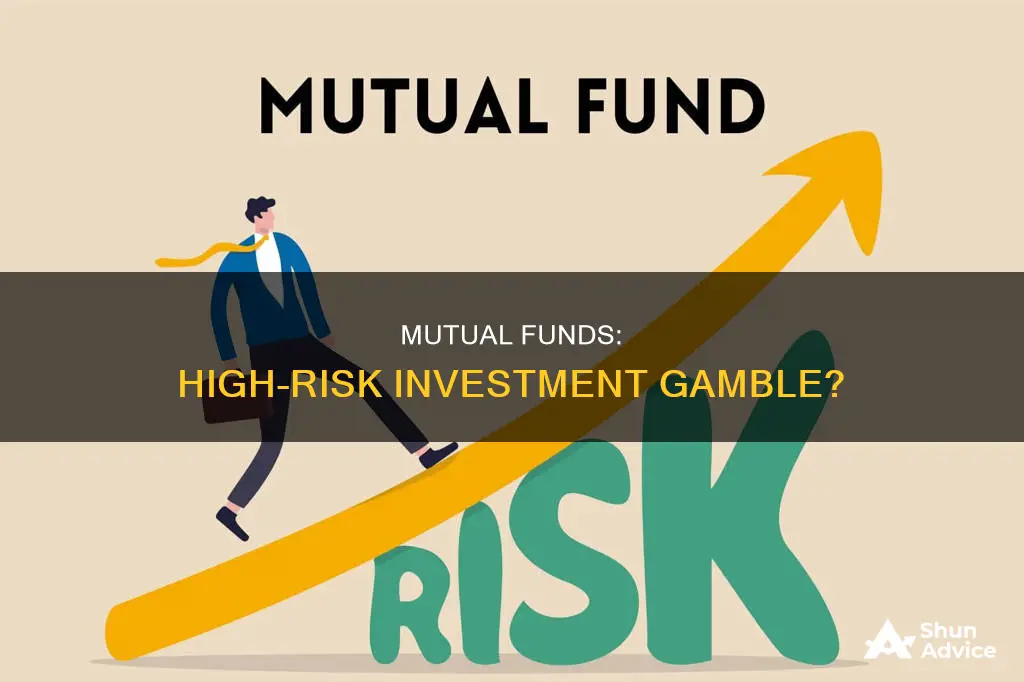
Mutual funds are a popular investment choice for many people. They are a type of investment vehicle that pools money from multiple investors to purchase a diversified portfolio of stocks, bonds, or other securities. The fund's performance depends on how its collective assets are doing. When these assets increase in value, so does the value of the fund's shares. Conversely, when the assets decrease in value, the value of the shares also goes down.
While mutual funds are a common investment option, the question arises: are they a high-risk investment? The answer depends on various factors, including the type of mutual fund, the underlying assets, and the investor's risk tolerance.
Some mutual funds are considered high-risk investments due to the nature of the assets they invest in. For example, high-risk mutual funds typically invest in stocks or equity with a higher potential for returns but also a higher risk of losing value. These funds are designed for investors who are willing to take on more risk in exchange for the potential for higher returns.
Additionally, the risk associated with mutual funds can vary depending on the specific fund and its investment strategy. Factors such as economic conditions, market trends, and fund management can all influence the level of risk. It is important for investors to carefully consider their risk tolerance and investment goals before investing in mutual funds, as there is always the possibility of losing some or all of the invested money.
| Characteristics | Values |
|---|---|
| Risk-reward ratio | High-risk mutual funds have a significant risk-reward dynamic. They have significant volatility but also offer sizeable returns. |
| Type | There are various categories of high-risk mutual funds, including balanced advantage schemes, credit risk fund schemes, and equity hybrid fund schemes. |
| Asset allocation | High-risk funds predominantly invest in stocks or bonds of developing or growing companies. |
| Long-term Capital Gains Tax | A 10% tax rate is applicable on gains exceeding Rs.1 lakh if the fund units are sold after one year. |
| Short-term Capital Gains Tax | Capital gains on equity-oriented high-risk funds held for less than a year attract taxation @15% + cess. |
| TDS | Dividend pay-outs of over Rs.5000 from equity-based high-risk mutual funds attract a 10% TDS. |
| Investment suitability | High-risk funds are most suitable for investors with in-depth knowledge of the market, a strong risk appetite, and a long-term investment horizon. |
| Investment modes | Investors can invest in high-risk mutual funds through Systematic Investment Plan (SIP) or lump sum. |
What You'll Learn

Mutual funds and their varying levels of risk
Mutual funds are a popular investment option, especially in India, as they offer a simple and convenient way to invest in the stock market, debt market, or both. They are a type of investment vehicle that pools money from multiple investors to purchase a diversified portfolio of stocks, bonds, or other securities.
While mutual funds are generally considered a safe investment option, not all mutual funds are created equal, and some carry a higher risk than others. The level of risk associated with a mutual fund depends on various factors, including the types of securities it invests in, its investment objectives, and the type of returns it seeks.
Types of Mutual Funds
Mutual funds can be broadly categorized into four main types: money market funds, bond funds, stock funds, and target date funds. Each type carries a different level of risk and potential return.
- Money market funds invest in safe, short-term debt instruments, such as government treasury bills, and are considered low-risk investments.
- Bond funds aim for higher returns and thus carry higher risks than money market funds. The level of risk in bond funds can vary significantly depending on the types of bonds they invest in.
- Stock funds invest in corporate stocks and can be further categorized into growth funds, income funds, index funds, and sector funds, each with its own risk profile.
- Target date funds hold a mix of stocks, bonds, and other investments, and their risk profile changes over time as they gradually shift to a more conservative approach as the target date approaches.
High-Risk Mutual Funds
High-risk mutual funds invest in assets with a higher potential for returns but also a higher risk of loss. These funds are designed for investors who are willing to take on more risk in exchange for the potential for higher returns. High-risk mutual funds often invest in stocks or equity, including small-cap and mid-cap stocks, which tend to be newer and riskier investments.
High-risk mutual funds are characterized by higher potential returns, volatility, and long-term investment horizons. They may also offer diversification opportunities by investing in a wide range of assets, including stocks, bonds, commodities, and real estate.
Factors Affecting Risk
The risk associated with mutual funds can be influenced by various factors, including economic conditions, market-specific factors, and the fund's performance. For example, actions by central banks and changes in interest rates can impact the performance and volatility of mutual funds.
Additionally, it's important to consider the fund's expense ratio, management fees, and other costs, as these can impact the overall returns of the investment.
Suitability
When considering investing in mutual funds, it's essential to assess your investment goals, risk tolerance, and financial capacity. High-risk mutual funds, in particular, are most suitable for investors with a strong understanding of the market, a high-risk appetite, and a long-term investment horizon.
It's also crucial to research the fund's performance, expense ratio, and past returns to make an informed decision.
In summary, mutual funds offer varying levels of risk depending on their investment strategies, asset allocations, and types of securities they invest in. High-risk mutual funds can provide the potential for higher returns but also carry a greater possibility of loss. Investors should carefully consider their financial goals and risk tolerance before investing in mutual funds.
Invest Like a Billionaire: Accessing Bill Ackman's Strategies
You may want to see also

High-risk mutual funds and their potential for higher returns
Mutual funds are a popular investment option, especially for those seeking a simple and convenient way to invest in the stock market or debt market. While they are known to offer diversification and professional management, not all mutual funds are created equal. Some carry a higher risk than others but also offer the potential for higher returns.
High-risk mutual funds are designed for investors who are willing to take on more risk in exchange for the potential of higher returns. These funds invest in stocks or equity that have a higher risk of losing value but also come with a higher potential for growth. As such, they are suitable for investors with a strong risk appetite who are comfortable with exposing their portfolio to volatility.
Features of High-Risk Mutual Funds
Higher Potential Returns
High-risk mutual funds may offer the potential for higher returns compared to other types of mutual funds. These funds typically invest in assets with higher volatility, such as stocks or emerging markets, which can generate higher returns over the long term.
Volatility
High-risk mutual funds are more volatile, and the value of investments may fluctuate significantly over time. This means that investors need to be prepared for potential losses as well as gains.
Diversification
High-risk mutual funds may also provide diversification benefits by investing in a range of assets, including stocks, bonds, commodities, and real estate. This helps to spread risk across different sectors and asset classes, potentially reducing the overall volatility of the portfolio.
Long-Term Investment Horizon
Investing in high-risk mutual funds typically requires a long-term investment horizon of at least 5-10 years. This is because the underlying investments are often in companies in their growth phase, and it may take time for their potential to be realized.
Professional Management
High-risk mutual funds are managed by professional fund managers with expertise in investing in high-growth companies. This provides investors with access to skilled money managers who actively monitor market trends and adjust the portfolio allocations.
Advantages of High-Risk Mutual Funds
Higher Returns
The primary advantage of high-risk mutual funds is the potential for higher returns. These funds invest in assets with higher volatility, which can lead to significant gains for investors who are comfortable with the associated risks.
Diversification Opportunities
High-risk mutual funds provide opportunities for diversification across different asset classes, sectors, and geographies. This helps to spread risk and potentially reduce the overall volatility of an investor's portfolio.
Opportunity for Growth
Investors with a longer investment horizon can benefit from the potential for compounding returns in high-risk mutual funds. These funds are suitable for those seeking growth and willing to tolerate short-term fluctuations in value.
Access to Specialized Markets
High-risk mutual funds may provide exposure to specialized markets or sectors that are not easily accessible through traditional investments. This includes sectors such as technology, healthcare, emerging markets, or commodities.
Active Management
Many high-risk mutual funds are actively managed, allowing fund managers to adjust the portfolio based on market trends and research. This active management may lead to better investment decisions and potentially improved performance compared to passively managed funds.
Suitability of High-Risk Mutual Funds
High-risk mutual funds are not suitable for everyone. They are designed for investors with a strong risk appetite and a long-term investment horizon. These funds require a willingness to accept volatility and potential losses in pursuit of higher returns.
Before investing in high-risk mutual funds, it is essential to assess your risk tolerance, investment goals, and financial capacity. It is also crucial to understand the fees and expenses associated with these funds, as they can significantly impact overall returns.
Strategic Timing for Long-Term Bond Fund Investments
You may want to see also

Long-term investment horizons
When considering long-term investment horizons, mutual funds can be a great option. The longer time horizon allows for higher risk tolerance, which can lead to greater returns. Here are some key points to consider:
- Time in the market: One of the most important factors in investing is time. The longer your investment horizon, the more time your investments have to grow and compound. This is especially beneficial when investing in high-risk mutual funds, as it provides a greater opportunity for the higher-risk investments to pay off.
- Risk and reward: High-risk mutual funds typically invest in stocks or bonds of developing or growing companies with a higher potential for returns but also a higher risk of loss. By investing in these funds over a long-term horizon, you increase the chances of realising those higher returns.
- Diversification: Mutual funds are known for providing diversification across a range of companies and industries. This diversification becomes even more important when dealing with high-risk investments. By diversifying your portfolio, you reduce the overall risk and protect yourself from significant losses if a particular investment doesn't perform well.
- Professional management: Mutual funds are managed by professional fund managers who have expertise in investing in high-growth companies. Their active management strategies can help maximise returns and minimise losses over the long term.
- Tax benefits: In some cases, mutual funds can offer tax advantages. For example, long-term capital gains tax rates may be lower than short-term rates, and certain types of funds may have specific tax treatments.
- Compounding returns: Over a long-term investment horizon, you can benefit from compounding returns. This means that any returns generated by the fund are reinvested, leading to exponential growth over time.
- Riding out market fluctuations: With a long-term investment horizon, you can better ride out short-term market fluctuations. This is especially important when dealing with high-risk investments, as there may be periods of high volatility.
When considering a long-term investment horizon, it's important to carefully evaluate your risk tolerance, investment goals, and the performance of specific funds. While high-risk mutual funds can offer the potential for higher returns, they also carry a higher level of risk, and it's essential to ensure that you are comfortable with the level of risk involved.
A Beginner's Guide to Index Funds on Webull
You may want to see also

Volatility and risk management
Volatility, a key indicator of risk, refers to the fluctuations in the value of an investment over time. High-risk mutual funds are more volatile, resulting in significant shifts in investment value. This volatility is inherent in the types of assets these funds invest in, such as stocks or equity. The potential for substantial gains is counterbalanced by an elevated risk of losing value.
To manage volatility and risk, high-risk mutual funds employ diversification strategies. They allocate their assets across a range of investments, including stocks, bonds, debt, and other securities. This diversification serves to mitigate overall risk. For instance, investing in both equity and debt instruments helps balance the higher risk of stocks with the more stable returns of debt instruments.
Additionally, high-risk mutual funds are designed for investors with a long-term investment horizon, typically spanning 5 to 10 years or more. This long-term perspective is essential for weathering the volatility and potential losses associated with high-risk investments. Investors in these funds must be comfortable with short-term fluctuations and focus on long-term growth potential.
The selection of a suitable high-risk mutual fund requires careful consideration of factors such as investment goals, risk tolerance, fund performance, expense ratios, and investment plans. It is imperative for investors to thoroughly understand their risk appetite and align it with the fund's characteristics.
In summary, high-risk mutual funds present a significant risk-reward dynamic. Effective management of volatility and risk involves diversification, long-term investment horizons, and prudent fund selection based on individual investor profiles.
Choosing a Fund: Key Factors for Investment Success
You may want to see also

Taxation on high-risk funds
Taxation on high-risk mutual funds can be complex and depends on several factors. Here is a detailed overview of the taxation implications for high-risk mutual funds:
Short-Term Capital Gains (STCG) Tax:
If you hold high-risk mutual fund units for less than a year, any gains are considered STCG and are typically taxed at a flat rate of 15% in India, plus applicable cess and surcharge. This rate may vary depending on your income tax bracket in other countries.
Long-Term Capital Gains (LTCG) Tax:
If you hold high-risk mutual fund units for more than a year, any gains are considered LTCG. In India, LTCG up to Rs. 1,00,000 in a financial year is tax-exempt. Gains exceeding this amount are typically taxed at a rate of 10% in India. It's important to note that LTCG tax rates and exemptions may vary depending on your country of residence.
Dividend Taxation:
Dividend distributions from high-risk mutual funds are generally taxed as ordinary income according to your income tax slab rate. However, there may be exceptions, such as qualified dividends or tax-free interest, which can be taxed at the lower capital gains tax rate or be tax-exempt.
Holding Period Impact:
The period for which you hold your investments can significantly impact the taxes you pay on capital gains. Longer holding periods generally result in lower tax liabilities, as many countries, including India, have tax policies that encourage sustained investments.
Fund Types:
For tax purposes, mutual funds are typically categorised into equity-oriented and debt-oriented funds. The tax treatment and rates may differ depending on the type of fund you invest in.
Securities Transaction Tax (STT):
When purchasing or selling units of an equity fund or a hybrid equity-oriented fund, you may be subject to STT, which is a transaction tax imposed by the Ministry of Finance. This tax is typically a small percentage of the transaction value.
Tax Deducted at Source (TDS):
In some cases, the budget may remove TDS on the repurchase of mutual fund units. This means you will receive the full amount without any TDS deduction, but you are still responsible for calculating and paying the appropriate capital gains tax when filing your income tax returns.
Tax Planning and Compliance:
Understanding the taxation implications of investing in high-risk mutual funds is crucial for effective tax planning and maximising your investment returns. Consult a tax professional or financial advisor to ensure you are compliant with the tax regulations in your country of residence.
Vanguard Funds: Best UK Investment Options
You may want to see also







